
Jan 22
/
Alef Dias
Grains, Oilseeds and Livestock Weekly Report -2024 01 22
Back to main blog page
Wheat: Prospects for the 24/25 EU crop
- With a start to the harvest characterized by delayed planting in France and Germany, which probably resulted in a decrease in the planted area in both countries, the projections for total production in the continent are now more positive compared to the estimates made two months ago.
- Still, the 24/25 harvest in the European Union is expected to be 2M mt smaller than the current crop, intensifying the pressure on the global balance. As a result, European wheat, which has been facing intense competition from Russian wheat in recent crops, tends to maintain its less competitive position in the 24/25 marketing year.
- In addition, the decrease in European production so far does not seem to have the potential to exert significant upward pressure on wheat futures contracts. However, productivity is still subject to substantial variations until the continent's harvest starts.
Introduction
After a start of the crop marked by delayed planting in France and Germany, which probably led to a reduction in the planted area in both countries, the market is beginning to analyze what impact this smaller area will have on total EU production.
This impact, as well as other relevant factors, will be analyzed in the present report to provide an overview of the EU's 24/25 wheat crop and address other issues relevant to the European market.
Fig. 1: Crop progress - Soft wheat France (% of estimated area)
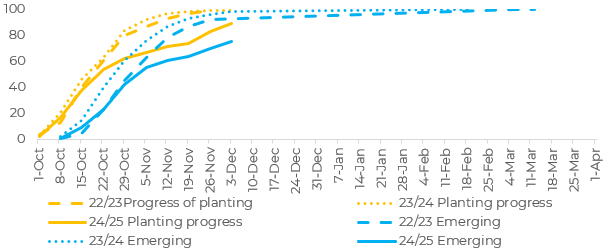
Source: France AgriMer
Fig. 2: Crop Conditions - Soft Wheat France
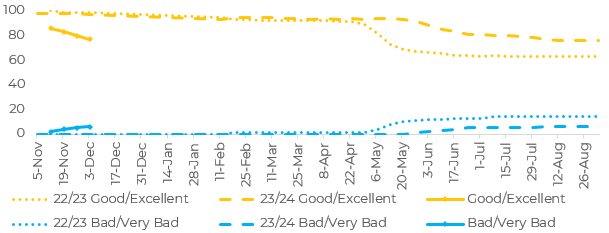
Source: France AgriMer
The smaller area should be significant, but less relevant than initially anticipated
In our last report on the 24/25 European harvest (click here to access), the first unofficial estimates pointed to a possible 8M mt reduction in the continent's total production.
At the start of the crop, there were already expectations of a reduction in EU's planted area, mainly due to the low prices, but the heavy rains in November led to a significant delay in planting, leading to an even greater reduction.
At the start of the crop, there were already expectations of a reduction in EU's planted area, mainly due to the low prices, but the heavy rains in November led to a significant delay in planting, leading to an even greater reduction.
About two months later, with the harvest progressing, and greater clarity about the total impact on the acreage and the crop situation in other countries, it is understood that this impact will likely be smaller.
Considering a drop of around 10% in the planted areas of Germany and France, and a lower yield in the latter, the next crop should be around 2M mt smaller than the 23/24 harvest. This is due to the fact that yields in the rest of the continent should be higher, reducing the impact of the smaller planted area.
Fig. 3: EU wheat - Area, yield and production (M ha, mt/ha, M mt)
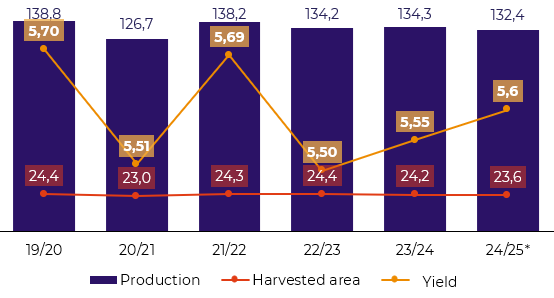
Source: USDA. *hEDGEpoint estimate
Now the focus is on productivity
With more clarity on the impact on the planted area, productivity is the main factor to watch over the coming months. In terms of temperature, there are not many indications of a deterioration in the European harvest at the moment.
Virtually the entire continent is expected to see above-average temperatures over the next few days, and even if this scenario changes, snow cover in several producing countries is above the average of the last 15 years.
In terms of rainfall, the scenario is more worrying. Despite heavy rainfall at the start of the harvest, soil moisture in several of the main producing countries is below the average of recent years. However, forecasts point to a change in this scenario in the coming days.
Fig. 4: Soil moisture (% within top 1 meter) - Germany
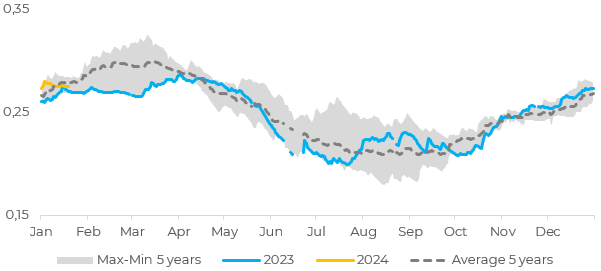
Source: Refinitiv
Fig. 5: Rainfall forecast for the next 15 days
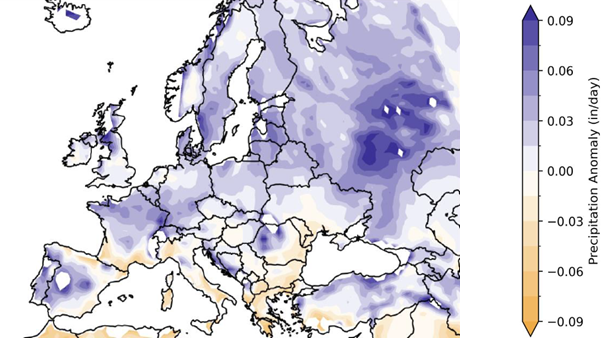
Source: NOAA, hEDGEpoint
In summary
After a start of the crop marked by delayed planting in France and Germany, which probably led to a reduction in the area planted in both countries, total production estimates for the continent are more optimistic than they were two months ago.
Still, the 24/25 crop in the EU is still expected to be 2M mt smaller than the current crop, putting more pressure on the global balance. As a result, European wheat, which has already suffered from competition with Russian wheat in recent crops is likely to remain less competitive in 24/25.
In addition, this reduction in European production does not - so far - appear to be capable of bringing significant upward pressure to wheat futures contracts. However, productivity is still subject to strong variations until the harvest starts.
Fig. 6: Cumulative EU soft wheat exports (M mt)
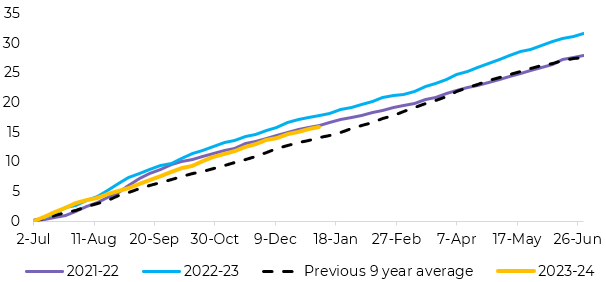
Source: European Commission
Weekly Report — Grains and Oilseeds
Written by Alef Dias
alef.dias@hedgepointglobal.com
Reviewed by Pedro Schicchi
pedro.schicchi@hedgepointglobal.com
pedro.schicchi@hedgepointglobal.com
www.hedgepointglobal.com
Disclaimer
This document has been prepared by hEDGEpoint Global Markets LLC and its affiliates ("HPGM") exclusively for informational and instructional purposes, without the purpose of creating obligations or commitments with third parties, and is not intended to promote an offer, or solicitation of an offer, to sell or buy any securities or investment products. HPGM and its associates expressly disclaim any use of the information contained herein that may result in direct or indirect damage of any kind. If you have any questions that are not resolved in the first instance of contact with the client (client.services@hedgepointglobal.com), please contact our internal ombudsman channel (ouvidoria@hedgepointglobal.com) or 0800-878-8408 (for clients in Brazil only).
Contact us
hedgepointhub.support@hedgepointglobal.com
ouvidoria@hedgepointglobal.com
Funchal Street, 418, 18º floor - Vila Olímpia São Paulo, SP, Brasil
This page has been prepared by Hedgepoint Schweiz AG and its affiliates (“Hedgepoint”) solely for informational and instructional purposes, without the purpose of instituting obligations or commitments to third parties, nor is it intended to promote an offer, or solicitation of an offer of sale or purchase relating to any securities, commodities interests or investment products. Hedgepoint and its associates expressly disclaim any use of the information contained herein that directly or indirectly result in damages or damages of any kind. Information is obtained from sources which we believe to be reliable, but we do not warrant or guarantee the timeliness or accuracy of this information. The trading of commodities interests such as futures, options, and swaps involves substantial risk of loss and may not be suitable for all investors. You should carefully consider wither such trading is suitable for you in light of your financial condition. Past performance is not necessarily indicative of future results. Customers should rely on their own independent judgement and/or advisors before entering in any transaction.Hedgepoint does not provide legal, tax or accounting advice and you are responsible for seeking any such advice separately.Hedgepoint Schweiz AG is organized, incorporated, and existing under the laws of Switzerland, is filiated to ARIF, the Association Romande des Intermédiaires Financiers, which is a FINMA-authorized Self-Regulatory Organization. Hedgepoint Commodities LLC is organized, incorporated, and existing under the laws of the USA, and is authorized and regulated by the Commodity Futures Trading Commission (CFTC) and a member of the National Futures Association (NFA) to act as an Introducing Broker and Commodity Trading Advisor. HedgePoint Global Markets Limited is Regulated by the Dubai Financial Services Authority. The content is directed at Professional Clients and not Retail Clients. Hedgepoint Global Markets PTE. Ltd is organized, incorporated, and existing under the laws of Singapore, exempted from obtaining a financial services license as per the Second Schedule of the Securities and Futures (Licensing and Conduct of Business) Act, by the Monetary Authority of Singapore (MAS). Hedgepoint Global Markets DTVM Ltda. is authorized and regulated in Brazil by the Central Bank of Brazil (BCB) and the Brazilian Securities Commission (CVM). Hedgepoint Serviços Ltda. is organized, incorporated, and existing under the laws of Brazil. Hedgepoint Global Markets S.A. is organized, incorporated, and existing under the laws of Uruguay. In case of questions not resolved by the first instance of customer contact (client.services@Hedgepointglobal.com), please contact internal ombudsman channel (ombudsman@hedgepointglobal.com – global or ouvidoria@hedgepointglobal.com – Brazil only) or call 0800-8788408 (Brazil only).Integrity, ethics, and transparency are values that guide our culture. To further strengthen our practices, Hedgepoint has a whistleblower channel for employees and third-parties by e-mail ethicline@hedgepointglobal.com or forms Ethic Line – Hedgepoint Global Markets.Security note: All contacts with customers and partners are conducted exclusively through our domain @hedgepointglobal.com. Do not accept any information, bills, statements or requests from different domains and pay special attention to any variations in letters or spelling, as they may indicate a fraudulent situation.“HedgePoint” and the “HedgePoint” logo are marks for the exclusive use of HedgePoint and/or its affiliates. Use or reproduction is prohibited, unless expressly authorized by HedgePoint. Furthermore, the use of any other marks in this document has been authorized for identification purposes only. It does not, therefore, imply any rights of HedgePoint in these marks or imply endorsement, association or seal by the owners of these marks with HedgePoint or its affiliates.

